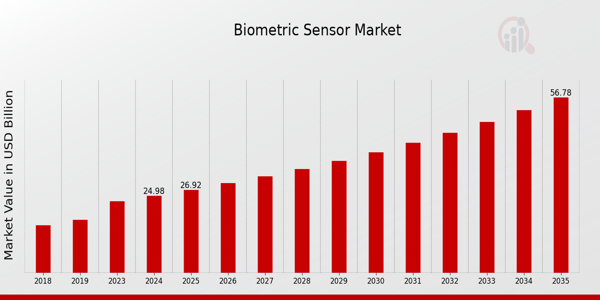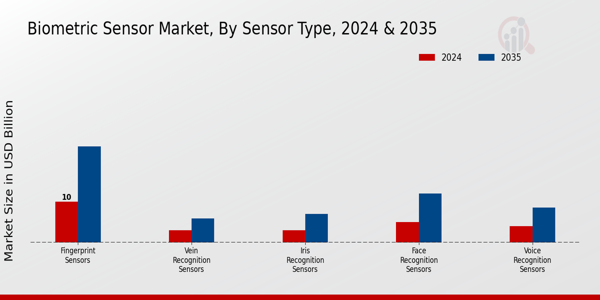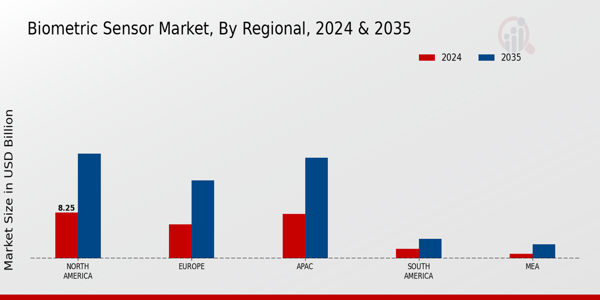Biometric Sensor Market Overview:
Biometric Sensor Market Size was estimated at 23.18 (USD Billion) in 2023. The Biometric Sensor Market Industry is expected to grow from 24.98(USD Billion) in 2024 to 56.8 (USD Billion) by 2035. The Biometric Sensor Market CAGR (growth rate) is expected to be around 7.75% during the forecast period (2025 - 2035).
Key Biometric Sensor Market Trends Highlighted
The Biometric Sensor Market is witnessing significant growth driven by increasing demand for enhanced security systems across various sectors, including government, healthcare, and banking. One of the key market drivers is the rising need for stringent security measures to protect sensitive information and personal data. As incidents of cyber threats and identity theft continue to rise, organizations are seeking biometric solutions such as fingerprint scanners, facial recognition, and iris recognition to improve access control and authentication processes. There are ample opportunities to be explored in this market, particularly with the expansion of IoT and smart home technologies.The interconnection of devices has increased the embedding of biometric sensors within smartphones, wearables, and smart locks.
This convergence improves user experience and the security of the connected systems as a whole. Moreover, there is increased adoption of biometric solutions in developing regions, which expands the market for supply and manufacturing. Recent trends indicate a greater emphasis on the acceptance of contactless biometric technologies due to hygiene and safety concerns brought on by the pandemic. Governments across the world are adopting measures that encourage the use of sophisticated biometric systems for identity verification to expedite services in public sectors.Additionally, advancements in artificial intelligence and machine learning facilitate more accurate and efficient biometric systems, making them increasingly reliable for users. The Global landscape encourages innovation and collaboration among stakeholders, creating a dynamic environment for the continued expansion of the biometric sensor market.

Source: Primary Research, Secondary Research, MRFR Database and Analyst Review
Biometric Sensor Market Drivers
Increasing Demand for Enhanced Security Solutions
The Biometric Sensor Market Industry is witnessing substantial growth driven by the increasing demand for enhanced security solutions. Rising concerns over personal and organizational security have led to the adoption of biometric systems in various applications, including access control, identity verification, and fraud prevention. According to the Global Information Security Workforce Study conducted by the (ISC), there is projected to be a shortage of 1.8 million cybersecurity professionals by 2022, highlighting the need for advanced security measures.Established organizations like the International Organization for Standardization (ISO) are continuously developing standards for biometric applications, further driving their adoption in the security industry. Furthermore, government initiatives to enhance national security through biometrics are acting as a catalyst for market growth, with countries like the United States implementing biometric screening at major entry points.
Technological Advancements in Biometric Technologies
The Biometric Sensor Market Industry is significantly benefitting from rapid technological advancements in the field of biometrics. Innovations in fingerprint recognition, facial recognition, iris recognition, and voice recognition technologies are enhancing the accuracy and efficiency of biometric systems. The National Institute of Standards and Technology (NIST) reports that the accuracy of biometric systems has improved dramatically, with the latest facial recognition algorithms boasting over 99% accuracy.This has resulted in greater confidence among user entities, driving widespread adoption across various sectors, including healthcare, finance, and law enforcement. Companies such as NEC Corporation and Thales Group are leading the way in developing cutting-edge biometric solutions that leverage these advancements to meet increasing market demands.
Rising Adoption of Biometrics in Mobile Devices
The growing trend of incorporating biometric sensors within mobile devices is acting as a significant driver for the Biometric Sensor Market Industry. With a surge in smartphone penetration, ranging from 41% in 2016 to an estimated 78% in 2023, manufacturers are increasingly integrating biometric functionalities such as fingerprint and facial recognition into their devices. The International Telecommunication Union (ITU) notes that mobile subscriptions worldwide reached approximately 8 billion in 2022, creating a vast market for biometric technologies.Major players like Apple and Samsung lead this trend by continually enhancing their biometric capabilities in flagship phones, consequently boosting consumer confidence and adoption rates across the globe.
Government Initiatives for Digital Identity Management
Government initiatives worldwide focusing on digital identity management are a strong driver for the Biometric Sensor Market Industry. Countries are increasingly implementing biometric systems for national identity programs, border control, and citizen identification initiatives. According to a report by the World Bank, over 1.1 billion people globally do not have an official identity, prompting governments to adopt biometric solutions for efficient identity verification.For example, India’s Aadhar initiative has successfully registered over 1.3 billion residents, utilizing biometric data for various services. Such programs have heightened the public's trust in biometric identification and significantly expanded the market, with worldwide investment in identity initiatives projected to reach billions annually.
Biometric Sensor Market Segment Insights:
Biometric Sensor Market Sensor Type Insights
The Biometric Sensor Market is segmented into various sensor types, which play a pivotal role in the market's growth trajectory. With a valuation of 24.98 USD Billion in 2024, the market was poised for expansion and innovation. Among the various sensor types, Fingerprint Sensors were significant, commanding a market value of 10.0 USD Billion in 2024 and expected to reach 23.5 USD Billion by 2035, making it a dominant player in the sector due to the extensive adoption in smartphones and security systems. Following closely, Face Recognition Sensors held a market share of 5.0 USD Billion in 2024, which is set to increase to 12.0 USD Billion by 2035, driven by their implementation in consumer electronics and surveillance.The Iris Recognition Sensors, while smaller, showed potential with a valuation of 3.0 USD Billion in 2024, progressing to 7.0 USD Billion by 2035.
This segment was particularly important for high-security applications, as iris patterns are unique and highly distinct. Voice Recognition Sensors was valued at 4.0 USD Billion in 2024 and are projected to grow to 8.5 USD Billion by 2035; they are increasingly integrated into smart devices, enhancing user convenience and access control. Meanwhile, Vein Recognition Sensors, which accounted for 2.98 USD Billion in 2024 and are expected to grow to 5.8 USD Billion by 2035, find their niche in secure environments, owing to their high accuracy and difficulty to replicate.Each of these sensor types contributes to the Biometric Sensor Market dynamics, addressing varied demands spanning security, convenience, and advanced technology, thus spurring market growth and presenting opportunities for future investment and innovation across the globe.

Source: Primary Research, Secondary Research, MRFR Database and Analyst Review
Biometric Sensor Market Technology Insights
The Biometric Sensor Market, particularly in the Technology segment, has shown promising growth patterns, with the overall market was valued at 24.98 USD Billion in 2024. This market encompasses various types of sensors, including Capacitive Sensors, Optical Sensors, Ultrasound Sensors, Infrared Sensors, and RFID Sensors. Capacitive Sensors are known for their application in mobile devices, enhancing user interface and security. Optical Sensors, often favored for their accuracy, play a significant role in high-security environments.Ultrasound Sensors, while gaining traction, provide unique features capable of leveraging biometric recognition in diverse applications.
Infrared Sensors cater to needs in security systems, owing to their ability to work effectively in low-light conditions. RFID Sensors offer advanced capabilities in scanning and identification, making them integral for access control solutions. Collectively, these technologies form an important framework supporting various industries, including security, healthcare, and consumer electronics, driven by increasing security concerns, technological advancements, and the growing demand for seamless user experiences, making them significant within the Biometric Sensor Market framework.
Biometric Sensor Market Application Insights
The Biometric Sensor Market has shown substantial growth within the Application segment was, valued at 24.98 billion USD in 2024. This growth is attributed to the increasing need for enhanced security and improved user experience across various sectors. The Access Control sector is crucial as organizations prioritize security measures, while Time and Attendance systems streamline workforce management, ultimately optimizing operational efficiency. Identity Verification applications are gaining traction, driven by the rise in online transactions and digital identity verification demands.
Smartphones and Tablets have become significant platforms for biometric sensors, enhancing user accessibility and convenience, reflecting a shift towards mobile technology. In the realm of Banking and Payment, biometric sensors are being integrated to prevent fraud and ensure secure transactions, making it a vital area in the market. As the market evolves, it continues to benefit from advancements in technology and growing consumer awareness, driving the Biometric Sensor Market revenue to new heights reflecting a robust market growth trajectory.The overall market dynamics present various opportunities for innovation and application expansion across these critical areas, which generally contributes to the development of Biometric Sensor Market statistics.
Biometric Sensor Market End Use Insights
The Biometric Sensor Market reached a valuation of 24.98 USD Billion by 2024, reflecting a robust growth trajectory across various end use sectors. Each sector plays a crucial role in the expansion of biometric technology; for instance, the government sector has been pivotal in implementing biometric systems for national security and identity verification purposes. The healthcare industry significantly benefits from biometric sensors through enhanced patient identification and health record management aimed at improving safety and efficiency.In retail, biometric sensors facilitate streamlined transactions and personalized customer experiences, thus optimizing operations and boosting sales.
The Banking and Financial Services sector relies heavily on these technologies to prevent fraud and secure customer data, illustrating a significant demand for reliable biometric solutions. Finally, the Consumer Electronics market leverages biometric sensors for user authentication, enhancing privacy and user experience. Overall, the Biometric Sensor Market segmentation reveals a dynamic interplay between these sectors, with each driving technological advancements that support market growth and address evolving security challenges.Factors such as increasing security concerns and the demand for more personalized services continue to propel the market forward, revealing substantial opportunities for further innovation.
Biometric Sensor Market Regional Insights
The Biometric Sensor Market exhibited significant growth across various regions, with notable valuations expected in the foreseeable future. In 2024, North America led with a valuation of 8.25 USD billion, primarily due to its advanced technology adoption and increasing security concerns. Following closely, Europe reached 6.15 USD billion, driven by stringent regulations regarding data privacy.
The APAC region is also significant, with a projected value of 8.0 USD billion, bolstered by its growing industrial base and demand for secure authentication in sectors like banking and healthcare.South America and MEA regions were on a smaller scale, valued at 1.75 USD billion and 0.83 USD billion, respectively, in 2024, yet they present substantial opportunities for growth owing to rising awareness about biometric technologies. The overall segmentation of the Biometric Sensor Market revenue reflects distinct regional variances, underlining the importance of local market strategies. While North America and APAC dominate the landscape significantly, the growth potential in South America and MEA showcases opportunities for expansion in emerging markets.Understanding these dynamics is crucial for stakeholders aiming to capitalize on market growth.

Source: Primary Research, Secondary Research, MRFR Database and Analyst Review
Biometric Sensor Market Key Players and Competitive Insights:
The Biometric Sensor Market is characterized by a dynamic and competitive landscape, driven by rapid technological advancements and increasing demand for secure identification solutions across various industries. In an era where security concerns are paramount, biometric sensors have become essential in applications such as access control, time and attendance tracking, and personal identification. The competition within this market is intense, with numerous players focusing on innovation and differentiation to capture market share. With the proliferation of connected devices and the Internet of Things, the demand for sophisticated biometric systems that integrate seamlessly with modern technology is expected to rise significantly.
Companies are investing heavily in research and development to enhance the performance, accuracy, and security of their biometric sensor offerings while also exploring partnerships and collaborations to expand their market reach.VERIDIFY has established a notable presence in the Biometric Sensor Market, leveraging its strengths in advanced technology and customer-centric solutions. The company has developed a robust portfolio of biometric sensors that cater to various sectors, including finance, healthcare, and law enforcement. Its focus on creating reliable and high-performance sensors has enabled VERIDIFY to build strong partnerships with industry players and government entities. The company emphasizes innovation, continuously evolving its products to meet changing market demands.
This commitment allows it to stay ahead of competitors while addressing the need for heightened security measures in a world increasingly reliant on digital transactions and personal data protection.Impinj operates as a key player in the Biometric Sensor Market, offering a range of products designed to enhance identity verification and secure access. Known for its innovative solutions, Impinj specializes in a variety of sensing technologies that enable seamless user experiences in various applications, such as smart buildings and retail environments. The company’s strengths lie in its ability to integrate biometric data with existing infrastructure, providing a comprehensive approach to security and authentication. Impinj's market presence has been reinforced through strategic mergers and acquisitions aimed at expanding its product offerings and enhancing technological capabilities. The focus on developing robust, scalable solutions that cater to global markets positions Impinj favorably, allowing it to play a significant role in the evolution of biometric technologies worldwide.
Key Companies in the Biometric Sensor Market Include:
- VERIDIFY
- Impinj
- Neurotechnology
- Morpho
- Precise Biometrics
- Fingerprints
- Groupe IDEC
- SecuGen
- hid Global
- Apple
- Gemalto
- Samsung Electronics
- Daon
- Crossmatch
- Aware
Biometric Sensor Market Industry Developments
Recent developments in the Biometric Sensor Market highlight the increasing integration of biometric technology across various sectors. Companies like Apple and Samsung Electronics continue to innovate with advanced fingerprint and facial recognition features in their devices, while Impinj and Neurotechnology are enhancing RFID and biometric identification systems for secure access and tracking. In terms of acquisitions, in March 2023, Morpho announced its acquisition of SecuGen to strengthen its biometric fingerprint recognition technology, indicating a consolidation trend among leading firms. Further, Precise Biometrics has reported a significant increase in its market valuation due to rising demand for identity verification solutions bolstered by growing concerns for cybersecurity.
Also noteworthy are the developments in biometric payment systems, particularly driven by Groupe IDEC and Daon, which are exploring seamless payment solutions through biometric verification. Over the past two to three years, significant enhancements in artificial intelligence within biometric systems, noted in Q2 2021, have further propelled the market's growth, ensuring more reliable and faster authentication processes. Overall, this market is rapidly evolving with continuous technological advancements, strategic mergers, and an increasing focus on security and convenience worldwide.
Biometric Sensor Market Segmentation Insights
Biometric Sensor Market Sensor Type Outlook
- Fingerprint Sensors
- Face Recognition Sensors
- Iris Recognition Sensors
- Voice Recognition Sensors
- Vein Recognition Sensors
Biometric Sensor Market Technology Outlook
- Capacitive Sensors
- Optical Sensors
- Ultrasound Sensors
- Infrared Sensors
- RFID Sensors
Biometric Sensor Market Application Outlook
- Access Control
- Time and Attendance
- Identity Verification
- Smartphones and Tablets
- Banking and Payment
Biometric Sensor Market End Use Outlook
- Government
- Healthcare
- Retail
- Banking and Financial Services
- Consumer Electronics
Biometric Sensor Market Regional Outlook
- North America
- Europe
- South America
- Asia Pacific
- Middle East and Africa
| Report Attribute/Metric Source: |
Details |
| MARKET SIZE 2023 |
23.18(USD Billion) |
| MARKET SIZE 2024 |
24.98(USD Billion) |
| MARKET SIZE 2035 |
56.8(USD Billion) |
| COMPOUND ANNUAL GROWTH RATE (CAGR) |
7.75% (2025 - 2035) |
| REPORT COVERAGE |
Revenue Forecast, Competitive Landscape, Growth Factors, and Trends |
| BASE YEAR |
2024 |
| MARKET FORECAST PERIOD |
2025 - 2035 |
| HISTORICAL DATA |
2019 - 2024 |
| MARKET FORECAST UNITS |
USD Billion |
| KEY COMPANIES PROFILED |
VERIDIFY, Impinj, Neurotechnology, Morpho, Precise Biometrics, Fingerprints, Groupe IDEC, SecuGen, hid Global, Apple, Gemalto, Samsung Electronics, Daon, Crossmatch, Aware |
| SEGMENTS COVERED |
Sensor Type, Technology, Application, End Use, Regional |
| KEY MARKET OPPORTUNITIES |
Increased demand for mobile security, Growing adoption in healthcare applications, Expansion in smart home technologies, Rising interest in biometric payment solutions, Government initiatives for secure identification |
| KEY MARKET DYNAMICS |
Increasing biometric authentication adoption, Rising demand for security solutions, Advancements in sensor technology, Government regulations and compliance, Growing use in healthcare applications |
| COUNTRIES COVERED |
North America, Europe, APAC, South America, MEA |
Biometric Sensor Market Highlights:
Frequently Asked Questions (FAQ) :
The Biometric Sensor Market is expected to be valued at approximately 24.98 USD Billion in 2024.
By 2035, the market is forecasted to reach a valuation of 56.8 USD Billion.
The market is anticipated to grow at a CAGR of 7.75% during the forecast period from 2025 to 2035.
North America is projected to dominate the market with an expected value of 18.75 USD Billion by 2035.
The Fingerprint Sensors segment is expected to be valued at 10.0 USD Billion in the year 2024.
Notable key players include companies like Apple, Samsung Electronics, and Impinj that have contributed significantly to the market.
The market for Face Recognition Sensors is projected to reach approximately 12.0 USD Billion by 2035.
Iris Recognition Sensors are expected to have a market value of 3.0 USD Billion in 2024.
The APAC region is anticipated to experience substantial growth, with an expected market value of 18.0 USD Billion by 2035.
The Voice Recognition Sensors segment is expected to be valued at 8.5 USD Billion by the year 2035.

















